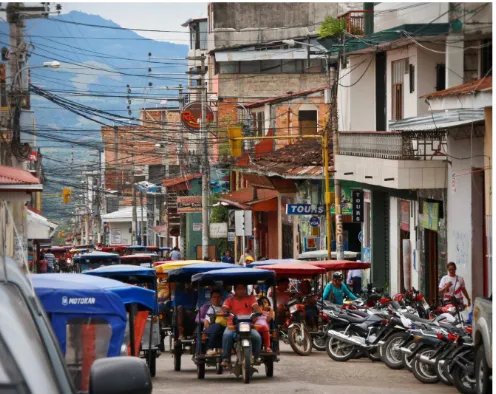Project summary
March 2017Water-Energy-Food Nexus approach
In the context of growing natural resource demands and climate change pressures, the interplay between water, energy and food security with socio-ecological factors is becoming increasingly more signiicant. This demands a better understanding of the complex natural resource interdependencies between urban and economic sectors, bio-physical surroundings and ecosystem services, and resource governance infrastructure. A Water-Energy-Food (WEF) Nexus framework provides an integrated and multidisciplinary approach that can help identify competing resource trade-ofs and risks which will need to be managed to guarantee climate resilient development.
Objectives
There are existing conservation and resource management eforts underway in the Cumbaza watershed, including a water PES mechanism with agricultural and urban water users that seeks to support upstream forest conservation initiatives. This project will support these ongoing initiatives by applying a WEF Nexus approach to:
1. Evaluate the interdependencies, trade-ofs and risks in the use, availability and management of natural resources across sectors and actors in Tarapoto and the surrounding Cumbaza watershed under diferent land use and climate change scenarios;
2. Inform the elaboration and adoption of integrated resource management and climate-risk mitigation strategies, actions and measures at multiple sectors and scales (city, districts, province and watershed) to improve water, energy and food security;
3. Galvanize support and inancial commitments for the extension of a water PES mechanism to inance climate resilient development activities;
4. Build capacity and promote understanding about the utility of the WEF Nexus concept for integrated resource management and climate resilient development.
Introduction
Rapid urbanization in the Peruvian Amazon, largely driven by migration and economic development, has increased pressure on forest resources, whose ecosystem services underpin water, energy and food security, essential for human wellbeing and the economic prosperity of the region.
Tarapoto, the main commercial and inancial urban centre in the department of San Martín, and the third largest in the Peruvian Amazon, is a prime example of these dynamics.
The availability and quality of water resources for urban and agricultural consumption is already being afected by severe environmental degradation in the surrounding Cumbaza watershed, largely linked to unsustainable agricultural practices, infrastructure development and urban growth.
Climate change and climate extremes, such as prolonged droughts, increased looding and extreme temperature luctuations, will further multiply the risks for urban and rural populations and hinder economic development in the watershed.
Strengthening
climate resilient development
in the Cumbaza watershed
Towards water, energy and food security in
urban-rural landscapes.
• 2 Strengthening climate resilient development in the Cumbaza watershed.
Project components, activities & outcomes:
This project has an 18-month timeframe (November 2016 – April 2018):
Project Partners:
This project is implemented by the Global Canopy Programme (GCP), in partnership with Centro de Desarrollo e Investigaciones de la Selva (CEDISA), Centro de Competencias del Agua (CCA), the Comité de Gestión de la Microcuenca del Cumbaza (CGMC).
